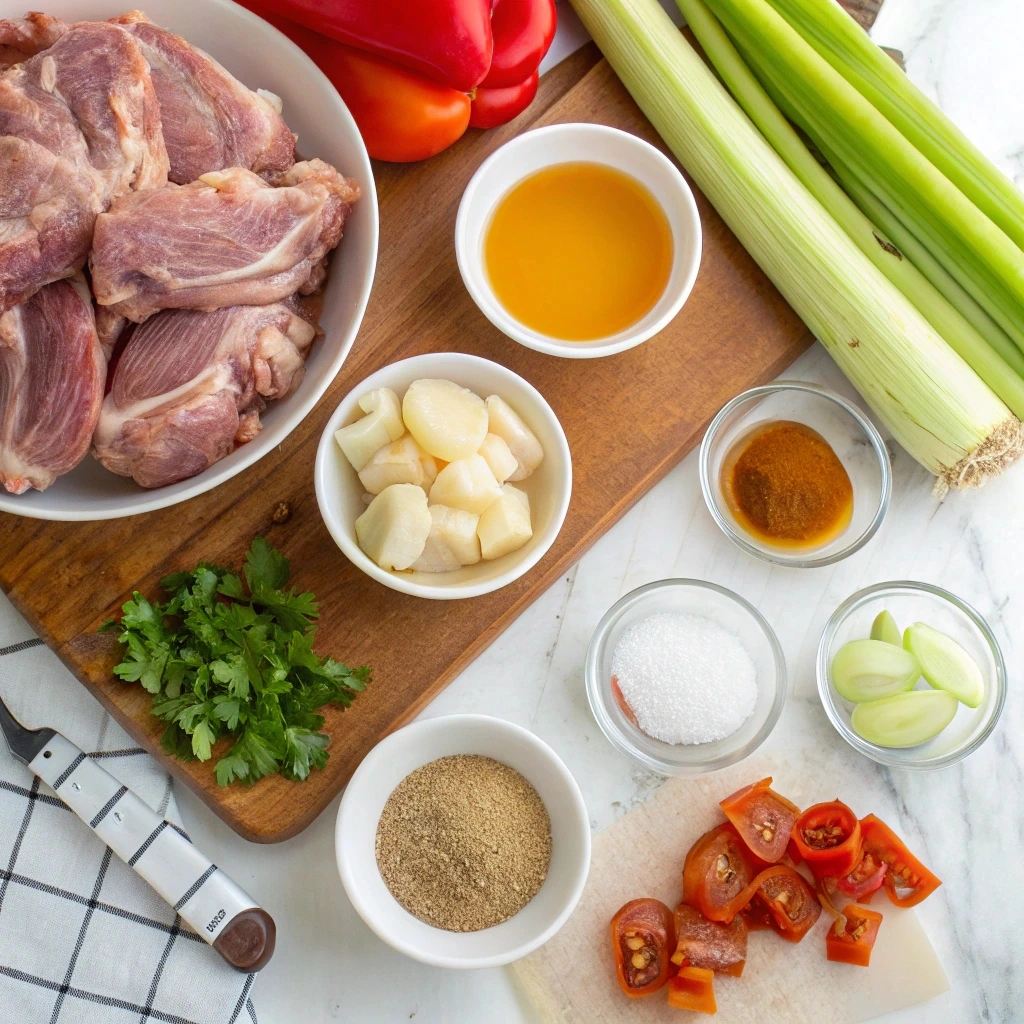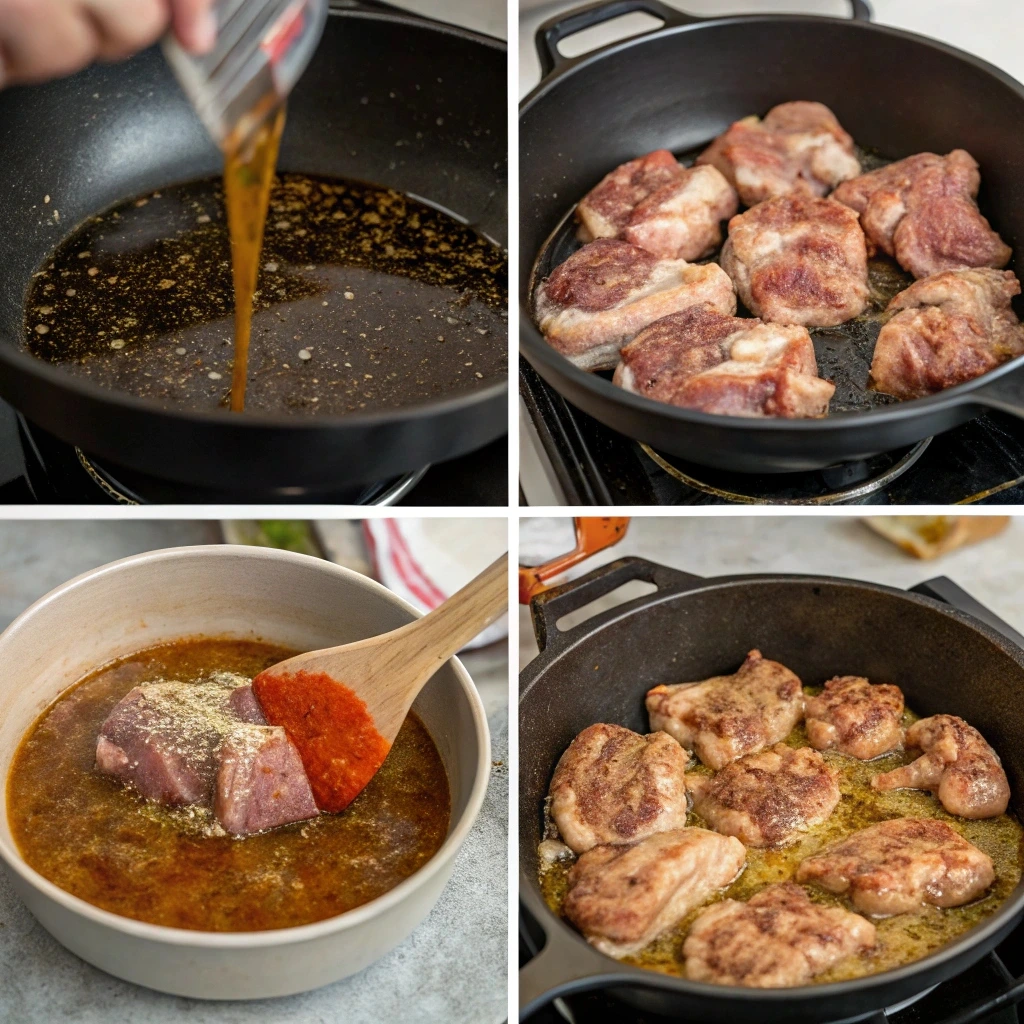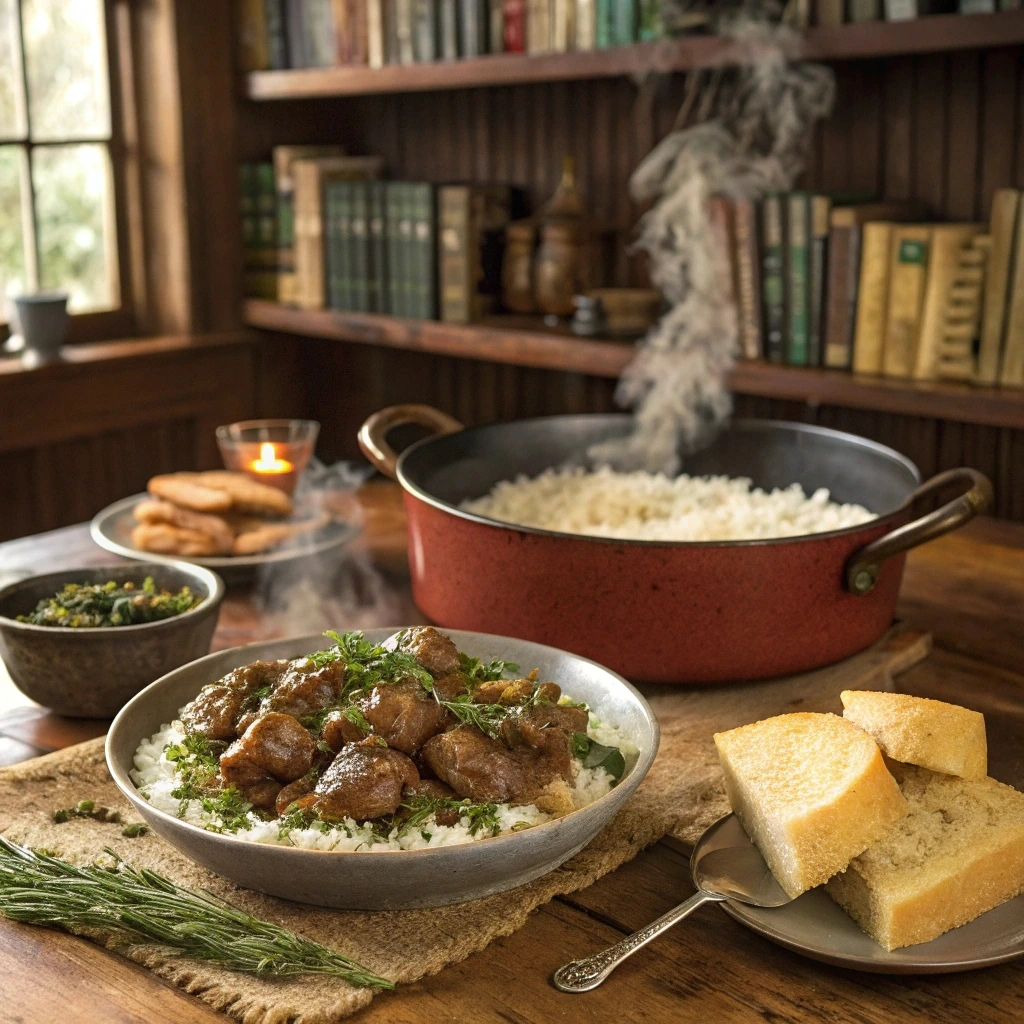If you’re on the hunt for a flavorful, hearty, and downright soul-satisfying meal, look no further than the humble turkey neck. Once considered a throwaway cut, this budget-friendly gem has made a huge comeback in kitchens across the South and beyond. In this guide, we’ll show you how to transform turkey necks into a mouthwatering dish that’s rich, tender, and full of Southern charm.
We’ll explore different cooking methods, must-have ingredients, and tips for getting that fall-off-the-bone tenderness. You’ll also discover how this underrated cut fits into classic dishes like gumbo, stews, or good ol’ gravy over rice. Whether you’re new to cooking turkey necks or looking to perfect your smothered turkey neck recipe, this guide’s got you covered from pot to plate.
Table of Contents
Introduction to Turkey Neck Recipes
What is a Turkey Neck?
A turkey neck is exactly what it sounds like — the neck of the bird. It may not sound glamorous, but let me tell you, it’s one of the most flavor-packed parts of the turkey. This meaty, collagen-rich cut is often used to flavor broths and gravies. But when cooked right, it can be the main event. And let’s be real — it’s a whole lot tastier than many people give it credit for.
In the culinary world, turkey necks are kind of like that hidden treasure in grandma’s old recipe box — overlooked by many but cherished by those who know. When simmered or braised low and slow, the meat turns meltingly tender and soaks up every ounce of seasoning. You can use the cooked meat in everything from tacos to casseroles, or just pile it over rice with rich gravy.
Why You Should Start Cooking Turkey Necks Today
If you’ve never tried a Turkey Neck recipe before, you’re in for a real treat. First of all, it’s budget-friendly. In fact, you can usually find these beauties for around $1 to $2 a pound. Secondly, they’re incredibly nutritious — packed with protein, minerals, and collagen, which is great for your joints and gut health.
But the biggest reason? The flavor. Turkey necks have a deep, rich taste that’s just begging to be seasoned with Cajun spices, herbs, and simmered into something special. Therefore, if you’re ready to shake things up in the kitchen and serve a dish that sticks to your ribs and warms your soul, it’s time to get cookin’!
Key Benefits of Cooking Turkey Neck
A Flavor-Packed Cut for Rich, Hearty Dishes
Let’s not beat around the bush — turkey necks pack a punch when it comes to flavor. While turkey breast often takes the spotlight, the neck is where the deep, meaty richness hides. Because of its higher fat and collagen content, the Turkey Neck recipe delivers tender, juicy meat that melts in your mouth.
Moreover, when simmered slowly, this cut creates an intense base for stews, gravies, or even standalone dishes. For example, tossing them into a gumbo or Southern stew adds a whole new layer of flavor. In contrast to lean cuts, turkey necks absorb seasoning beautifully, making every bite worth the wait.
Budget-Friendly and Nutritious
Here’s a bonus — turkey necks are super affordable. At just a couple of dollars per pound, they stretch your grocery budget without skimping on taste. That’s why many families have turned to this old-school favorite for Sunday dinners and special gatherings.
In addition, turkey necks are surprisingly good for you. They’re rich in protein, phosphorus, and zinc. Plus, the collagen from the slow cooking helps support joint health. Therefore, if you’re aiming for tasty and healthy, this is a win-win.
So, the next time you’re staring at a pricey protein, consider the humble neck — it may just become your new favorite.
Types of Turkey Neck Recipes
Smothered Turkey Necks in Cajun Gravy
If there’s one Turkey Neck recipe that screams comfort food, it’s the smothered version. This Southern staple involves browning the necks, then letting them cook low and slow in a flavorful brown gravy. As a result, the meat falls right off the bone, soaking up all that savory sauce.
Smothered turkey necks are often served over rice or mashed potatoes — the kind of meal that warms your soul. What makes them so good? It’s the “Holy Trinity” of Cajun cooking: onion, celery, and bell pepper. Combined with spices like thyme, cayenne, and garlic, you’ve got a gravy that’s hard to resist.
Braising vs. Simmering: Which Method to Choose?
Now, there’s more than one way to tackle a Turkey Neck recipe. Braising and simmering are two of the most popular. Braising starts by searing the meat in a hot pot, followed by a slow cook in the oven. The result? Tender turkey necks in a rich, concentrated sauce.
On the other hand, simmering skips the oven. You cook the necks on the stovetop in a broth or seasoned liquid until the meat becomes fork-tender. While both methods work wonders, simmering tends to be quicker and easier, especially for beginners.
In addition, you can try cooking them in a slow cooker or pressure cooker for extra convenience. No matter the method, the outcome is the same — juicy, flavorful turkey necks that steal the show.
Ingredients You’ll Need for a Classic Turkey Neck Recipe

The Cajun-Creole Trinity and Essential Spices
Before you dive into any Turkey Neck recipe, it’s crucial to gather your ingredients. The backbone of flavor here is the holy trinity of Cajun cooking — onions, celery, and bell peppers. These veggies build that soulful base every good gravy needs. In addition, you’ll need garlic, fresh thyme, and bay leaves to round out the aroma.
Moreover, spice is key. Cajun or Creole seasoning, paprika, and a touch of cayenne pepper all bring that Southern heat and depth. Don’t forget a good broth — chicken stock works best, but you can use turkey broth for added richness.
If you’re looking for the perfect side to pair this with, you might enjoy Authentic Southern Cornbread from PopinRecipes — it’s a match made in Southern comfort heaven.
Ingredient Table
| Ingredient | Quantity |
|---|---|
| Turkey necks | 3–4 lbs |
| Onion (chopped) | 1 medium |
| Celery stalks (chopped) | 2 |
| Bell pepper (chopped) | 1 |
| Garlic cloves (minced) | 4 |
| Chicken broth | 4 cups |
| Cajun seasoning | 2 tbsp |
| Thyme (fresh) | 3–4 sprigs |
| Bay leaves | 2 |
| Paprika | 1 tsp |
| Cayenne pepper (optional) | ¼ tsp |
| Flour (for gravy) | ½ cup |
| Oil or butter | 2 tbsp |
| Salt and pepper | To taste |
Therefore, having everything prepped ahead will save time and keep your cooking flow smooth. Let’s get that pot ready!
Step-by-Step Smothered Turkey Neck Recipe

Step 1: Prepping the Turkey Necks – Cleaning and Seasoning
Start by rinsing your turkey necks under cold water. Then, pat them dry with paper towels. This not only keeps things clean but helps the seasoning stick better. Now, season them generously with Cajun seasoning, salt, and black pepper. For even more flavor, let the seasoned necks sit for 30 minutes at room temperature.
Step 2: Browning for Extra Flavor
Next up — browning. Heat oil or butter in a heavy-bottomed pot over medium-high heat. Sear each side of the turkey necks until golden brown. This step is optional, but highly recommended because it adds rich, savory notes to your dish.
Step 3: Building a Cajun Gravy with Holy Trinity Vegetables
Once the meat is browned, remove it from the pot and set it aside. In the same pot, add a bit more oil and toss in your chopped onion, bell pepper, and celery. Sauté for about 5 minutes, until the veggies are softened. Then, stir in garlic, thyme, bay leaves, and paprika. Cook for another minute or two.
Sprinkle in the flour and stir constantly until the mix turns a warm golden brown — like peanut butter. This forms the base of your gravy.
Step 4: Slow Baking for Tenderness – How Long is Just Right?
Gradually whisk in your chicken broth to the pot, scraping up the flavorful bits from the bottom. Bring the mixture to a boil, then reduce the heat and return the turkey necks to the pot. Cover tightly and place in a preheated oven at 300°F (150°C).
Bake for about 3 to 3½ hours. Stir halfway through, and if the gravy looks too thick, just add a splash more broth.
Step 5: Final Touches – Garnishes and Side Pairings
Once your turkey necks are fall-apart tender, remove them from the oven. Let them rest for a few minutes in the gravy — trust me, it makes a difference.
Serve them hot over fluffy white rice, buttery mashed potatoes, or even grits. For extra flair, garnish with fresh parsley and chopped green onions.
Now that you’ve nailed this Turkey Neck recipe, you’re officially ready to impress. In fact, once your friends taste this, they’ll be begging you to make it again!
Cooking Techniques Explained: Simmer, Braise, or Roast?
Simmering on the Stovetop – Easy and Classic
When it comes to cooking a flavorful Turkey Neck recipe, simmering is one of the simplest and most trusted methods. In this technique, the turkey necks are gently cooked in seasoned broth over low heat. This helps the meat turn fork-tender while soaking up the spices and herbs around it.
First, you bring your pot to a gentle boil, then reduce it to a simmer. Add onions, garlic, and bay leaves — and let the magic happen. After about 2 hours, the meat becomes so soft it practically falls off the bone.
In addition, simmering is ideal if you’re multitasking in the kitchen. It requires little attention, making it great for weeknight meals.
Braising in the Oven – Intensifies Flavor
However, if you’re aiming for deep, concentrated flavor, braising is your go-to. This method begins by browning the turkey necks, then slow-cooking them in a covered pot with flavorful liquid inside the oven. Braising locks in moisture and builds complexity in the gravy.
Set your oven to a low 300°F. After searing, add your veggies and broth, return the meat to the pot, cover it, and pop it in the oven. Let it braise for 3 hours or until the meat is melt-in-your-mouth tender.
Therefore, braising might take more time upfront, but the flavor payoff is huge. Plus, your house will smell amazing for hours.
For faster meals, you can also use a pressure cooker or slow cooker. Both methods work beautifully and save time without sacrificing flavor.
Tips for Maximum Flavor and Tenderness
How to Choose the Best Turkey Necks at the Store or Butcher
Choosing the right meat is the first step to a great Turkey Neck recipe. Look for necks that are thick and meaty — avoid thin, bony ones with little flesh. If possible, ask your butcher to cut larger pieces in half. This helps them cook evenly and faster.
Also, go for fresh turkey necks if available. While frozen is fine, fresh always gives better texture and taste. And don’t forget to check the label — skip the smoked kind unless your recipe calls for it.
Browning, Marinating, and Seasoning Tips for Extra Depth
Here’s the deal: browning matters. Searing the turkey necks in a bit of oil before simmering or braising adds loads of flavor. It also locks in juices and gives the gravy a rich, deep color.
Moreover, you can marinate the necks overnight in your favorite seasoning mix — Cajun, Creole, or garlic-herb. This step isn’t required, but it’s a game-changer for taste.
For an even bolder twist, consider seasoning the flour before making your roux. That way, your gravy doesn’t just taste like flour — it tastes like heaven.
Finally, let your cooked turkey necks rest in the sauce for a few minutes before serving. Trust me, those last few minutes make a big difference in flavor.
Serving Suggestions for Turkey Necks
Pairings: Over Rice, with Mashed Potatoes, or Grits
Now that you’ve cooked the perfect Turkey Neck recipe, let’s talk about how to serve it. The most popular choice? Over fluffy white rice. The rice soaks up all that rich gravy, turning it into a full-on comfort meal. However, if rice isn’t your thing, creamy mashed potatoes work just as well.
For a more Southern spin, serve the turkey necks with buttery grits or even a slice of cornbread on the side. In fact, pairing your dish with Authentic Southern Cornbread can take it from good to unforgettable.
Therefore, no matter what you choose, make sure it complements the bold, savory flavors of the turkey neck gravy.
Creative Uses: Sandwiches, Tacos, Casseroles
But wait — don’t stop at dinner plates! The tender meat from this Turkey Neck recipe can also be repurposed in fun and creative ways. For example, shred the meat and pile it onto sandwich buns for a homemade BBQ-style lunch.
Or, toss it into tacos with slaw and a spicy sauce. In addition, you can mix the meat into casseroles, stir-fries, or even gumbo. Because the meat is so juicy and flavorful, it works in just about anything.
So go ahead — make a big batch. Leftovers never tasted so good.

Common Mistakes to Avoid When Cooking Turkey Necks
Not Cooking Long Enough
One of the most common mistakes with any Turkey Neck recipe is not cooking the meat long enough. Because turkey necks are full of connective tissue, they need time — a lot of it — to become tender. If you rush the process, you’ll end up with chewy meat that lacks flavor.
Therefore, always simmer or braise your necks for at least 2 to 3 hours. Trust the process, and your patience will pay off.
Skipping the Browning Step or Using Water Only
Another big mistake? Skipping the browning step. While it’s tempting to toss everything into the pot and walk away, taking five extra minutes to sear the necks makes a huge difference. Browning boosts flavor and gives your gravy that deep, rich color.
Also, avoid using plain water as your cooking liquid. Instead, use chicken or turkey broth to enhance the flavor. In addition, adding herbs and veggies like garlic, onions, and bay leaves gives the dish extra depth.
Frequently Asked Questions (FAQs)
How long should you cook turkey necks for best results?
The key to a great Turkey Neck recipe is time. Because turkey necks are tough and full of connective tissue, they need to cook low and slow to become tender. Typically, you’ll want to simmer them on the stovetop for 1.5 to 2 hours, or braise them in the oven for 3 to 3.5 hours.
However, if you’re using a pressure cooker or Instant Pot, you can cut that time down to about 45 minutes to an hour. Just make sure the meat is soft enough to fall off the bone easily — that’s when you know it’s ready.
What can you do with the turkey neck besides gravy?
Great question! While gravy is a classic, the cooked meat from a Turkey Neck recipe can be used in soups, stews, tacos, sandwiches, and even pasta bakes. For example, toss it into a pot of gumbo for an added layer of flavor. Or shred it and stuff it into empanadas — the options are endless.
In addition, turkey neck meat adds a rich texture and bold taste to casseroles and stir-fries. So don’t toss those leftovers — repurpose them creatively!
Is turkey neck meat healthy?
Yes, turkey neck meat is surprisingly good for you. It’s high in protein, collagen, and essential minerals like phosphorus and zinc. Moreover, because it’s often cooked with herbs, veggies, and broth, it becomes a nutrient-rich dish with plenty of gut-friendly benefits.
That said, watch your sodium if using store-bought seasoning blends — or better yet, make your own at home.
Can you use smoked turkey necks in the same way?
Smoked turkey necks bring a completely different flavor to the table. While you can still use them in a Turkey Neck recipe, they’re better suited for soups, beans, or greens where their smoky essence can shine without overwhelming the dish.
So yes — but use them wisely, depending on the flavor you’re aiming for.

